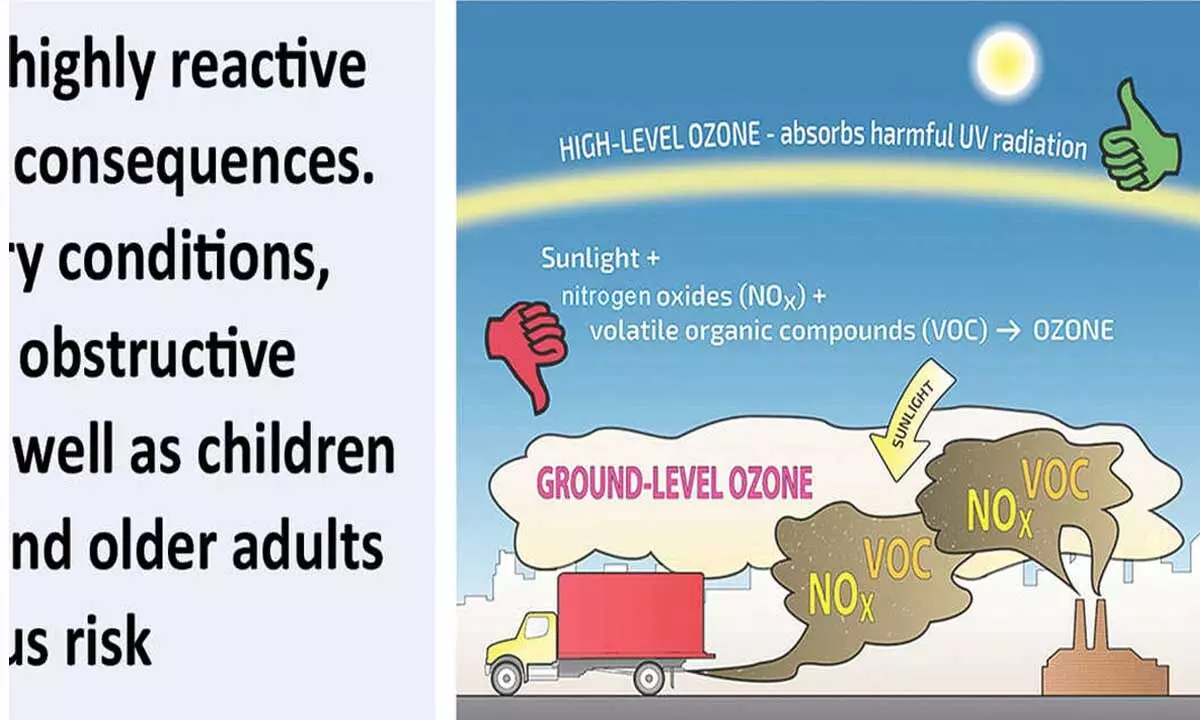Ground-level ozone rising in major cities

Duration of exceedance long and unhealthy across all metropolitan areas
Ground-level ozone, a highly reactive gas, has serious health consequences. Those with respiratory conditions, asthma and chronic obstructive pulmonary disease – as well as children with premature lungs and older adults -- are at serious risk
New Delhi:A new nation-wide analysis by Centre for Science and Environment (CSE) says that in the summer of 2024, the levels of ground-level ozone in the air went up in the 10 major metropolitan areas of India.
These areas and cities include Bengaluru Metropolitan Area (Karnataka), Chennai Metropolitan Area (Tamil Nadu), Delhi-NCR, Greater Ahmedabad (Gujarat), Greater Hyderabad (Telangana), Greater Jaipur (Rajasthan), Kolkata Metropolitan Area (West Bengal), Greater Lucknow (Uttar Pradesh), Mumbai Metropolitan Region(Maharashtra) and Pune Metropolitan Region (Maharashtra).
Says Anumita Roychowdhury, executive director, research and advocacy, CSE: “Ground-level ozone, a highly reactive gas, has serious health consequences. Those with respiratory conditions, asthma and chronic obstructive pulmonary disease – as well as children with premature lungs and older adults -- are at serious risk. This can inflame and damage airways, make lungs susceptible to infection, aggravate asthma, emphysema, and chronic bronchitis and increase the frequency of asthma attacks leading to increased hospitalisation.”
The 2020 State of Global Air report states that age-standardised rates of death attributable to ground-level ozone is among the highest in India. The seasonal eight-hour daily maximum concentrations have recorded one of the highest increases in India between 2010 and 2017– about 17 per cent.
Ozone needs special attention – ground-level ozone is not directly emitted from any source. It is produced from complex interaction between nitrogen oxides (NOx) and volatile organic compounds (VOCs) that are emitted from vehicles, power plants, factories, and other combustion sources and undergo cyclic reactions in the presence of sunlight to generate ground-level ozone. VOCs can also be emitted from natural sources, such as plants.
As the National Clean Air Programme (NCAP) gears up for its second phase, its reform agenda has to address the multi-pollutant crisis and the combined threat from PM2.5, ozone, nitrogen oxides and other gases. Global experience shows that there is usually a trade-off -- as particulate pollution gets reduced, the problem of NOx and ground-level ozone increases. This requires significant tightening of the regulatory benchmark for ozone to address the toxic emisisons from industry, vehicles, households and open burning.
According to Avikal Somvanshi, programme manager, Urban Lab, CSE, who has led the CSE study, “in 2024, we have found that the geographical spread of the problem is much wider than what we had seen in the lockdown summer of 2020 in most metropolitan areas.
This time’s toxic build-up has lasted longer in locations affected by the problem. Even the smaller metropolitan areas have witnessed rapid increase.
In metropolitan areas in the south and western coastal belt, the problem is not limited only to the summer months.”
Key highlights
Ground-level ozone exceedance has been reported in all 10 metropolitan areas, with Delhi being the most affected: This year, so far, Delhi-NCR has recorded 176 days of exceedances during the study period. Mumbai-MMR and Pune are tied at the second spot with 138 days of exceedance each. Jaipur recorded an exceedance on 126 days; Hyderabad, on 86 days; Kolkata-KMA, 63 days;Bengaluru, 59 days; Lucknow, 49 days; and Ahmedabad, 41 days. The least number of exceedance was recorded in Chennai: a mere nine days.
Ground-level ozone exceedance is more frequent during summer for Delhi-NCR, Jaipur, Kolkata-KMA, Lucknow, Ahmedabad and Chennai. In Mumbai-MMR, Pune, Hyderabad, and Bengalure, more exceedances were reported during January-March than during the summer (April-July). A massive increase in ground-level ozone exceedance is reported in smaller metropolitan areas. Ground-level ozone hotspots are located in areas with low levels of NO2 and PM2.5: The spatial distribution of ground-level ozone is the inverse of NO2 and PM2.5. This bears out the fact that while ozone is created in polluted areas with nitrogen oxide being the catalyst, it also gets mopped up in high NO2 areas as it further reacts. But the ozone that escapes to cleaner areas with less NO2 builds up faster, as unavailability of NO2 hampers its dissipation.
Critical to act immediately
Says Roychowdhury: “This finding has significant implcations for the NCAP programme that is currently focusing more on controlling PM10 or coarse dust. India must immediately refine the action strategy for combined control of particulate pollution, ozone and its precursor gases like NOx to maximise the co-benefits of the action plan. We need stringent control of precursor gases from vehicles, industry, cooking on solid fuels, open burning and other combustion sources while reducing PM2.5.”
Simultaneously, the country needs to develop a robust public information and dissemination system to alert the public about ozone exceedance – wherever ozone build-up is happening.















